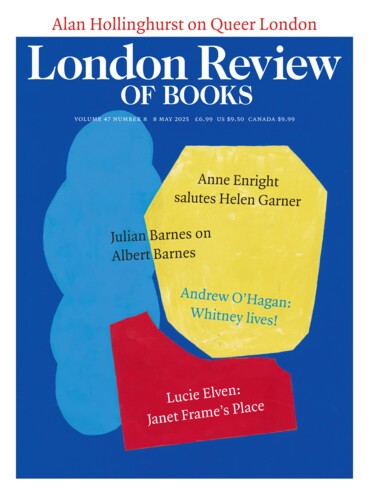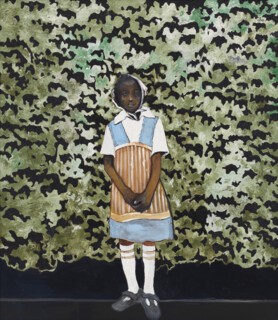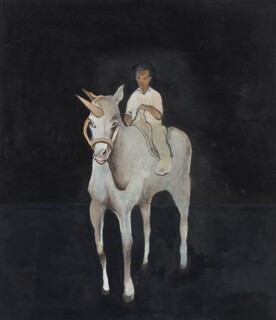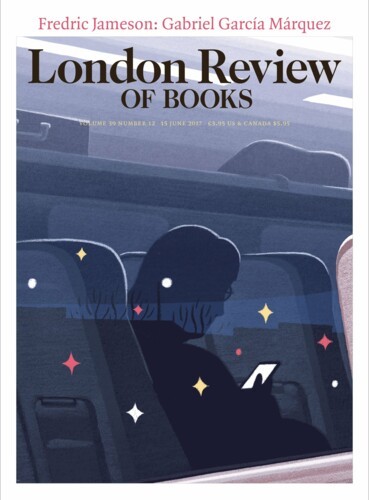Born in Seattle in 1983, Noah Davis had just turned 32 when he died of cancer in 2015, but his vast canvases, painted in near transparent washes, cool tones and deep blacks, are the work of a mature artist. The Barbican retrospective (until 11 May) opens with a group of works made in 2007-8, a few years after Davis arrived in Los Angeles from New York, where he had cut short his studies at the Cooper Union, frustrated by the emphasis on conceptual training over painting as process. ‘I left school because it wasn’t teaching me anything,’ he later said. ‘It shouldn’t be an either/or battle between concepts versus paintings. They can exist together.’
These early works depict fantastical tableaux, domestic scenes, portraits of childhood and boundless landscapes. Bad Boy for Life (2007) shows a mother and son in a tightly cropped scene, at once highly detailed and flattened. The perspective is condensed so that the objects, furniture and figures of the scene appear to exist on the same shallow plane, pressing towards the viewer. An angry mother – so angry her mouth has disappeared, replaced with a soft blur – bends her son over her lap, hand raised in the opposite of benediction. This is no Pietà or scene of maternal devotion. The boy’s mouth and eyes are wide with anticipation, his arms and legs stiffly extended. Both mother and child are dressed somewhat formally. Elegant high-heeled boots peek out from beneath the woman’s long crimson skirt, which forms a vivid contrast to the boy’s gold-hued coat and trousers. He is wearing what appear to be riding boots. Bad Boy for Life is as much a comment on clichés about Black life (Diddy took on similar tropes in a 2001 hit of the same name) as it is a scene of daily life. Maybe the ‘bad boy for life’ wasn’t attending to his equestrian lessons and will scamper off once he’s received his punishment. With Davis’s work it’s best not to make assumptions. Mary Jane (2008) shows a little girl wearing an old-fashioned pinafore, her hands clasped in front of her, before a riotous background of mottled green and pitch black. A mass of foliage? A camouflage pattern? A homage to Clyfford Still’s late style? The black extends to the bottom of the image to form the simply demarcated ground on which the girl stands. This is no place: this is a vision, a painted surface, and it knows it.
Davis’s shades of black are exquisite. His pictures contain countless blacks, almost impossibly subtle variations. (I thought of Rembrandt, Goya, Rothko and other sfumato masters of darkness.) The black background behind the boy on the unicorn in Forty Acres and a Unicorn (2007) – a reference to the unrealised Civil War promise to grant freed families ‘forty acres and a mule’ – is all-consuming. It’s not clear whether the boy is emerging from or being swallowed back into the dark swathe of disappointed history. A horizon, barely visible, gives the unicorn a ground to stand on. LA Nights (2008) and Painting for My Dad (2011) are both dominated by immense night skies. In LA Nights, the sky seems starless, perhaps obscured by the electrical lights of the city below. A tiny full moon is high in the sky. In Painting for My Dad, made just before Davis’s father’s death, a dark sky filled with stars is framed by a craggy curve of rock at the precipice of which stands a man holding a lantern, peering gingerly into the void. As in so many of Davis’s works, the space of the image is slightly off: the man seems to be up in the sky, though the rock face looks flat and difficult to climb. Where to next? his posture seems to say.
Davis spoke of his desire ‘to show Black people in normal scenarios’: ‘You rarely see Black people represented independent of the civil rights issues or social problems that go on in the States. I’m looking to move on from that stage.’ There are ‘normal scenarios’ in Davis’s paintings but his use of colour, the relationship of figures to space and his deliberate, painterly interventions – that blurred mouth – upset any suggestion of straightforward fidelity. He often worked from photographs, both his own and other people’s, as well as found images, which contributes to the dreamlike quality of some of the paintings: their strange hues and sense of double displacement. But the configuration of space and many of the more surreal or fantastic elements must have come from Davis’s imagination. Indeed, the mysterious black ground from which many of the scenes emerge could be considered just that.
Isis (2009) depicts Davis’s wife, the artist Karon Davis, as the Egyptian goddess who gathered her husband’s severed parts and brought him back to life. It has become a prophetic painting: as Karon describes in the catalogue, she now spends much of her time locating and curating her husband’s work. Davis’s Isis is an apparently ordinary woman standing in the sun behind a clapboard wooden house. A pine tree casts dappled shade over the scene; an abandoned air conditioner sits to one side. In Karon’s account, Davis was entranced by some large fans she was painting (they had previously been decorated with ancient Egyptian motifs) and asked her to pose for a photograph. In the painting he made from it, the fans become a weightless golden disc that almost completely encircles Isis. Osiris is just visible, too, reflected in a murky black window.
A series of large works from 2013, all titled 1975 and awash in blues, greens, browns and yellows, are based on photographs taken by Davis’s mother while she was a high-school student in Chicago. Figure and ground threaten to merge in these paintings, as though the subjects are so absorbed in their activities that they become part of their surroundings. Pools feature in two of them, the bright blue water blurring and concealing swimmers. The gaze of the viewer is doubled and tripled. Davis’s handling of paint recalls Marlene Dumas and Luc Tuymans – blurs, drips, washes that don’t quite fill the canvases – and his moments of magical realism owe something to Peter Doig, but his work is distinguished by a revelry and a commitment to the figures he brings into this image world. There are few non-Black subjects here. That in itself was a political choice, as well as an aesthetic one, but Davis goes further, not just making visible the everyday but envisioning something beyond it.
A year later, having undergone a first round of chemotherapy, Davis turned his attention to Pueblo Del Rio, an inner city housing project in South Los Angeles. Designed in part by the Black modernist architect Paul Revere Williams, the estate was intended to be a ‘garden city’ that promoted community and shared spaces. Instead, it became notorious for poverty and crime. In Davis’s paintings, Pueblo Del Rio appears in unearthly shades of violet, aquamarine, ochre and emerald. Its residents are frozen in theatrical tableaux as – dressed to the nines, but oddly weightless – they conduct invisible orchestras, play trumpet solos or stand in rows performing tidy balletic arabesques. They speak to what the place once was and what it might have been. There are suggestions here of Manet and Degas, of a bourgeois high culture flourishing alongside the modernist architecture, but the paintings wear their associations lightly.
‘There is immense freedom in painting to create your own universe,’ Davis said, ‘if you don’t let “Art History” or pretence get in the way … These elements of fantasy may arise from my need to break the spell, or the constraints of art theory, and move more into the realm of mysticism.’ Davis was also, however, involved in creating change on a tangible scale, and spent his last months working towards realising the Underground Museum, a series of linked storefront spaces in Arlington Heights that he wanted to transform into a museum of world-class art for the local population. When gallerists ignored his calls, he made imitations – fluorescent lights for a Dan Flavin, a Hoover in a vitrine just like Jeff Koons – as well as filling the space with his own world-class work. Helen Molesworth, then director at the Los Angeles Museum of Contemporary Art, was the only institutional representative who loaned something to the Underground Museum – a William Kentridge film, which was shown shortly before Davis’s death. It’s displayed at the Barbican alongside a reconstruction of the museum with his imitation artworks.
Davis continued to paint his immense canvases until the end. The final work in the exhibition, Untitled (2015), shows a man on a sunny sidewalk, walking past a wall painted in oblongs, like an abstract composition. His dark skin and clothes render his form silhouette-like, but the paint is almost transparent and the wall behind shows through in places. The loose brushwork, drips and blotches of the figure render him less realised yet more visually intriguing than anything else in the scene. Davis was always sensitive to the ephemerality of his medium, and his images invite us to meditate on form as much as subject. Untitled is a man, but he is also a painting.
Send Letters To:
The Editor
London Review of Books,
28 Little Russell Street
London, WC1A 2HN
letters@lrb.co.uk
Please include name, address, and a telephone number.



